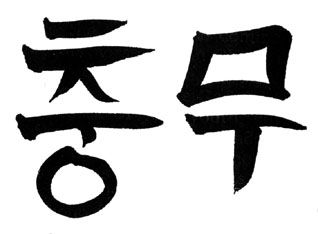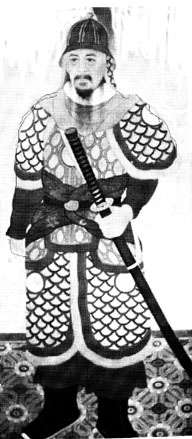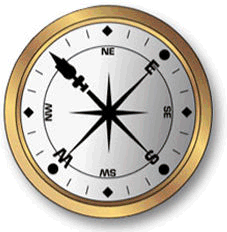Yi Sun-Shin and his navy defeated many Japanese warships for his time. In August, 1592, 100,000
Japanese troops were encountered at Pyongyang peninsula. Admiral Yi first pretended to
flee, then turned and sank 71 enemy ships! When Japan sent
reinforcements, Yi's navy sank 48 more. The Japanese commander, who knew not of the
battle, sent a message to Korean King Son-Jo, that "100,000 men are coming to reinforce
me. Where will you flee then?" The king was elated when he found out that Admiral Yi had destroyed
them! Son-Jo bestowed upon Admiral Yi all possible honors and recognition for his heroic deeds and bravery in defense of his
country.
Japan, meanwhile, sent a spy named
Yosira, to convince Korean general Kim Eung-Su, that he would help Korea by spying
on the Japanese. General Kim believed Yosira when he told him that a great number of ships was coming to destroy Korea.
General Kim begged King Son-Jo to send Yi to defend Korea against this
attack. However, Admiral Yi knew the area that Yosira said that he should wait for the
Japanese, and knew the area to be dangerous, with many sunken rocks. Yi refused to
go. Learning this, Yi was replaced, arrested, beaten and torutured. He was sentenced to
death, but was saved because his supporters at court rallied to Son-Jo to spare his life based on his service
record. The king demoted Yi to foot soldier. Yi performed his duties honorably and without
complaint. He remained a loyal and honorable soldier even in the face of the
humiliation wrongfully bestowed upon him.
After the Japanese destroyed most of the Korean navy under General Kim's
command, Yi was reinstated. By this time, he only had 12 shops left, but no shortage of men. His troops flocked back to Yi in service of their country under this great
man. When the Japanese sent a fleet of 133 ships, Yi destroyed many of
them, even though he had only 12 ships. The Japanese navy fled, only to return the next day with several hundred more
ships. Surrounded, Yi and his navy managed to sink 30 boats, then chased and killed the Japanese
commander Madasi. After this battle, and the somewhat peaceful time Korea enjoyed due to his
victories, Yi was able to rebuild his navy.
When China sent Admiral Chil Lin to Korea to protect the western coast of Korea so that Japan could not invade China, Lin
took credit for victories that Yi was responsible for. This made China feel
successful, and they bestowed aid to Korea. Yi put aside his pride because of his love for Korea, and the realization that the most important thing should be his country's
protection. He did not seek the esteem that these victories brought to Admiral Chil
Lin, although it was certainly due to him.
Admiral Yi died in battle in 1598. He died when he was hit by a stray
bullet. Before he died, he said "Do not let the rest know I am dead, for it will spoil the fight". Even at
death, Yi knew that what was important was protection of his country. In
1643, the title "CHOONG MOO" was bestowed upon Admiral Yi. The
"sting" of Admiral Yi's navy hurt Japan so badly, that they did not attempt to return until 1904. Choong Moo literally means
"loyalty-chivalry". Admiral Yi Sun-Shin was the embodiment of these
qualities.
In the world that we live in today, those qualities are very admirable and
desired, indeed. As Tae Kwon-Do practitioners, they are our duty, and we should strive to be more loyal and chivalrous as was Admiral
Yi. We should strive to set the kind of selfless example that Admiral Yi
demonstrated. We should not be vain, nor seek glory for ourselves. We should not be
scornful or seek retaliation, even in the face of injustice. This is the example set forth by
Yi. He should be our role model, and we should set forth to be such a role model to our
friends, families, children, co-workers, community, and lastly country.
When we do our forms, we should think about the person that we are supposed to be
exemplifying. Yi's regrettable death, which came before Yi was able to reclaim the honor that was due
him, is symbolized in the end of the form Choong Moo, by the left hand
attack. When we perform the form named after Admiral Yi Sun-Shin, we should be thinking
"loyalty-chivalry". |



